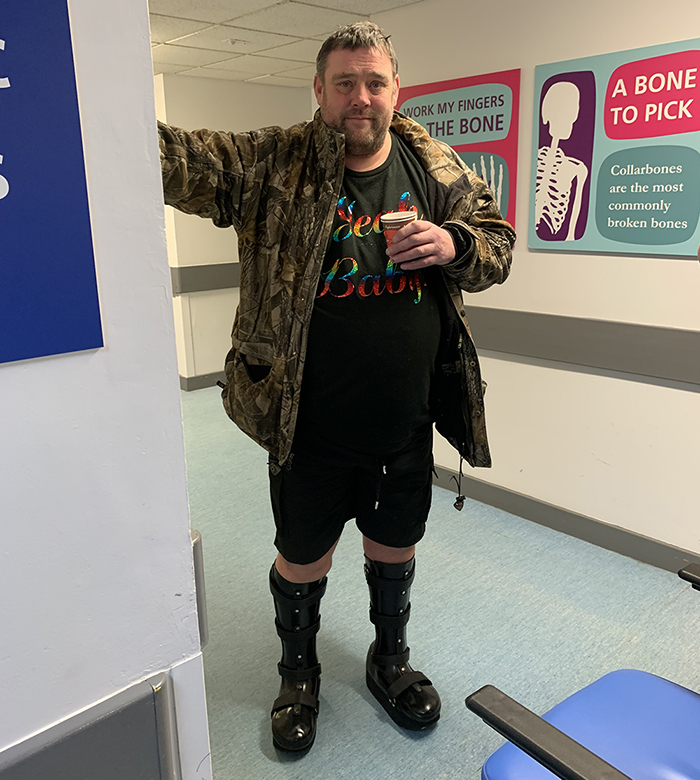Martin, a former painter decorator, is 50 and lives in Scarborough, North Yorkshire. He’s lived with diabetes for over a decade, but a diagnosis of Charcot foot two years ago has had life-changing effects. We spoke to him in June 2024 about the impact that Charcot foot has had on his life.
“I feel like my feet don’t belong to me anymore”
A diagnosis of diabetes and peripheral neuropathy
“I’ve been a self-employed painter decorator for many years. My job involves lots of time on my feet, which I’ve always had no problem doing. About ten years ago, I was diagnosed with diabetes. It’s been a real challenge getting the diabetes under control and as a result I ended up with peripheral neuropathy in both feet”
Peripheral neuropathy causes you to lose feeling in your feet. That means you may not notice pressure or injuries that lead to blisters and sores. Diabetes can also make these wounds difficult to heal and increases the chance of infections. This is exactly the situation Martin found himself in in 2021.
Thank goodness amputation was not the answer…
“I got ulcers on both my feet. They just appeared. I ended up in hospital for two weeks because they got infected and weren’t healing. The doctors thought they might have to amputate both my feet but fortunately they managed to get the infection under control and the ulcers very slowly started to heal”
Diagnosis of Charcot foot
Unfortunately, this was just the beginning of Martin’s significant challenges with his feet: “A few months after the ulcers had healed, I was working on a job in Whitby and my foot started swelling up. It just kept swelling and swelling until I could barely walk. I went back to the local hospital in Scarborough, but the vascular team said that they were going to have to transfer me to York hospital because they suspected it was Charcot foot and there was a risk I could lose my foot”
Charcot foot is a serious complication of diabetes-related neuropathy. It’s where the bones of the foot become very fragile and can start to break or dislocate under even a small amount of pressure – sometimes just from walking. There’s currently no cure for Charcot foot and treatment is focused on taking the weight off the foot through rest and walking aids and putting the foot in a cast to protect from any further injury.
“After a few months of treatment, they managed to get the Charcot under control in that foot. But then a few months later, my other foot started to swell. I was eventually referred to the podiatry team who X-rayed my foot and confirmed that I had Charcot in my other foot as well. It’s really rare to get it in both feet, so I felt very unlucky.
Tough times for Martin
“It’s had a massive impact on my life. You can’t put any weight on your feet, so I was sat in a wheelchair for 15 months with casts on both feet. You can’t shower properly. It’s hard to sleep. I’ve not been able to work. I’m self-employed so there’s no sick pay. It’s been really tough mentally. You get quite suicidal at points. You’d wake in tears just thinking “why me?”
Nearly 3 years on from the diagnosis of Charcot foot, Martin is able to walk short distances wearing Charcot Restraint Orthotic Walker (CROW) boots – a rigid boot designed to support the foot and ankle – but he is still unable to do many of the things he could before.
“I can walk maybe 20-30 yards before I have to stop because walking in the CROW boots aggravates my back. I’m not back at work and realistically I’m not sure I’ll ever get back to my old job because I’d need to be on my feet, so I’ll have to think about retraining, which is not easy at 50 years of age.”
“A big loss has been fishing. I’ve always loved fishing, but I can’t drive anymore because of the CROW boots, so I’m reliant on other people to take me. People say “oh, I’ll take you” but then they don’t. Friends have drifted away a bit because when you can’t get out and do stuff, they stop inviting you. There has been one friend – and actually it was someone who I really didn’t think would – who has stayed in touch and taken me fishing a few times. It can be surprising who is there for you when things get tough”
Martin’s amazing treatment team
Another source of support for Matin has been the relationships that he’s built up with his health care team, including podiatrist nurse Gill and plaster technician Elaine.
“They’ve really got me through this. They don’t just ask about my feet – we’ll chat about lots of other things too. I celebrated my 50th birthday a few weeks with a BBQ in my garden and Elaine came over. They’re diamonds”.
Martin’s hopes for the future
In terms of the future, Martin is hoping that one day he may be able to drive again, which would give him the independence he’s not had for the past three years. He’s also hoping that his feet gradually start to feel more ‘normal’ to him. “It’s the strangest feeling. I look down at my feet and know that they belong to me, but they don’t feel like they do. It’s like I’m walking around on two breeze blocks”

Need to know more?
Find out more about Charcot foot including what to look out for
Other support
If you’ve been affected by any of the issues raised in theses stories, the following organisations may be able to provide help and advice.
NHS Choices the official NHS website, which provides vital information and support about leg and foot signs and other symptoms.
Contact details
Call 111 - for non-emergency medical advice
Find out more on the NHS Choices website
Foot in Diabetes UK Part of Diabetesonthenet.com Foot in Diabetes UK is an organisation dedicated to continuous improvement in the care and management of people with diabetic foot problems.
Contact details
020 3735 8244
info@diabetesonthenet.com
Find out more on the Foot in Diabetes UK website
The Lindsay Leg Club Foundation Promoting and supporting community based treatment, health promotion, education and ongoing care for people who are experiencing leg-related problems - including leg ulcers and other wound care issues.
Contact details
01473 749565
lynn.bullock@legclubfoundation.com
Find out more on the Lindsay Leg Club Foundation website
Society of Tissue Viability (The Society of Tissue Viability) aims to provide expertise in wound management to all healthcare professionals.
Contact details
hello@societyoftissueviability.org
Find out more on the Society of Tissue Viability website
Mind Mind is the UK’s leading mental health charity. They're there to make sure no one has to face a mental health problem alone you can call or text for free anytime.
Contact details
0300 123 3393 or text 86463
info@mind.org.uk
Find out more on the Mind's website
Samaritans Samaritans are there 24 hours a day, 365 days a year providing emotional support to anyone in emotional distress. Call them free any time, from any phone.
Contact details
116 123
jo@samaritans.org
Find out more on the Samaritans' website
Tell us what you think
If there’s anything you want to ask us or tell us, whether it’s a suggestion about our website, a complaint, or a compliment, drop us a line at
support@legsmatter.org









